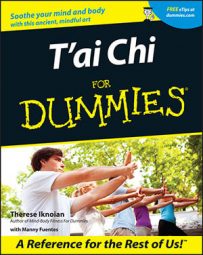Practicing T’ai Chi on a regular basis may give you physical and mental benefits, depending on how much, at what intensity, with what seriousness, and how often you incorporate it into your life.
Some of the benefits listed here aren’t completely proven by fully recognized scientific studies. Nonetheless, the various benefits of T'ai Chi may include the following:
Better cholesterol levels
Decreased depression
Decreased risk of cardiovascular disease
Increased immunity (less sickness)
Increased muscle strength and flexibility
Less lower back pain
Less asthma
Developing better balance with T'ai Chi
Good balance has been easier to study than some other areas. And T’ai Chi develops this skill well. The physical balance that you can hone through the movements in T’ai Chi can train the proprioception of the nerves and muscles (basically, the muscle sense). When the muscles and nerves can sense correctly how and when to contract or fire, you don’t fall or get hurt. Staying upright can help decrease not only sports injuries but also broken hips in seniors, especially if a senior’s bones are affected by bone-weakening osteoporosis.
Stamping out stress with T'ai Chi
A slow and prolonged exhalation (the breathing out part of breathing) has been shown to enhance a reaction in the body that causes overall muscular relaxation. If you are more relaxed, you handle your stress and your emotions more easily, and you may even sleep better.
When you aren’t bound up by stress and anxiety, you feel better on a day-to-day basis. But living without stress and anger may also lower your blood pressure, lower your bad cholesterol level, and cause decreases in other factors that can raise your risk of heart disease.
Managing chronic disease with T'ai Chi
Chronic disease can mean any number of medical conditions, such as diabetes, hypertension (high blood pressure), arthritis, fibromyalgia (a muscle disease that causes ongoing pain), or just chronic pain. Practicing full and deep breathing can stimulate the lungs and can cause positive increases in the amount of air you can get into and out of your lungs. If you can get more air in and more air out, you may be able to diminish the effects of asthma or other breathing ailments.
People with arthritis or other kinds of joint pain know that every move can hurt, so they tend to move less. And the reduced movement causes the muscles and tendons that support their joints to get very weak. Over the years, studies have shown that simple, gentle movements help relieve arthritis and other chronic pain and allow people with these ailments to function better day-to-day. T’ai Chi has been used as the gentle movement needed to stimulate the joints and free up movement to relieve pain. This same kind of movement may help alleviate chronic pain.
Fostering fitness with T'ai Chi
Maybe T’ai Chi is also about complementing your overall fitness — balancing muscles, strengthening them, helping them become more flexible, or helping your heart and lungs develop more aerobic capacity. Maybe you want to finish a marathon or ride a bike better up hills. Even the gentle movements involved in T’ai Chi can help.
For someone old or young who is very out of shape, the gentle movements of T’ai Chi can push muscles to get stronger and more flexible. Of course, if you push your forms a bit faster, make the squatting movements lower, or make the kicks higher, you can improve your muscles and flexibility even more — perhaps as much as with some traditional exercise. Some studies in Asia have shown more flexibility and strength as a result of a T’ai Chi practice.

